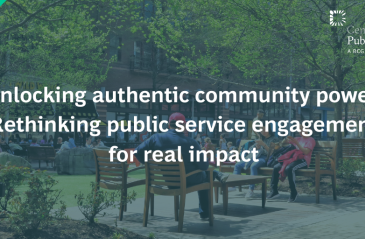
The power of storytelling in climate leadership

City officials in Rio are using data from public and private partners to design public policy
Share articleData is being used to tackle Rio's top three issues – security planning, health, and traffic
Share articleData and technology can help lead the way to a more democratic, more participative government
Share articleWe put our vision for government into practice through learning partner projects that align with our values and help reimagine government so that it works for everyone.
Standing with Pablo Cerdeira, Rio's first chief data officer, we have arguably the best view of the city. We're not up on Christ the Redeemer or Sugarloaf Mountain, but inside Rio's three-storey Operations Centre, looking down over its mission control. The whole city is represented in front of us in multiple dimensions on a huge wall of screens - live video footage combined with traffic data, weather predictions, and maps of current incidents including floods, accidents, and power failures.
Much has been written about Rio's use of real-time data to provide coordinated emergency response. But we're here to ask Cerdeira about another, more proactive use of this data, championed by his organisation PENSA.
“The mayor created PENSA - room of ideas - in 2013,” Cerdeira tells us. “Our objective is to use data from public and private partners to design public policy. We have created a huge database, capable of processing up to 50 billion records, including cellphone data, bus GPS, and data collected through our partnership with Waze.”
PENSA has used this data to tackle some of the city's toughest challenges, including its top three issues - security planning, health, and traffic. PENSA's record is impressive. In just over three years, it has launched over fifty projects - from tackling dengue fever (a mosquito-borne disease) to preventing floods to identifying new waste sites. PENSA has seen Rio implement many of its proposed solutions, leading to an estimated US$50m of savings. And all this from a team of just six people. So what has been the key to their success?
“First,” says Cerdeira, “it's been critical to build partnerships across the private sector - for example with Waze, Strava, cellphone companies, and so on - and academia, for example with Fundação Getúlio Vargas and Massachusetts Institute of Technology (MIT). Not only does this provide us with crucial leverage, in some cases it has also helped to open up data.”
Cerdeira explains how the partnership with Waze has enabled PENSA to help tackle one of the city's most pressing problems - traffic. “Over 9% of the city's GDP is wasted by people sitting in traffic jams,” he says. “Through our partnership with Waze, and the reports sent by our citizens, we were able to measure the cost of every single traffic jam in the city, and therefore how long it would take to pay back the cost of an intervention in that area. For example, we calculated that an intervention in the second-worst traffic area would break even financially after 4-5 years. In this way, we were able to prioritise interventions and quickly start to implement them. Now traffic in the city has improved to the level of 10-20 years ago. It's the equivalent of giving six days per year back to every citizen - time they used to spend in traffic.”
The second element that has been critical to PENSA's success is political support. “From the outset, we had the full support of the mayor,” Cerdeira told us, “and this is critical given our crosscutting approach, which can sometimes bring us into conflict with established city departments. Some departments were initially sceptical of our data-based approach. However, once we were able to demonstrate some good outcomes, by the time the Olympics came around we were working together in close collaboration with almost every department.”
Through its data-driven understanding of where people in the city travel to and from, PENSA was able to provide analysis in support of the locations of the Olympics sites and to help design the new infrastructure required to support them.
“The Olympics site selection was supported by two projects that we did with the aim of decreasing traffic congestion and increasing productive hours,” explains Cerdeira. “We realised that 70% of citizens live in two areas of the city (in the north and west), but most jobs are concentrated elsewhere. Based on this analysis, we supported a fifty-year plan (Visão Rio 500) to start to relocate jobs closer to where people live. The Olympics sites were chosen to stimulate these areas.
“But of course, these sites would create additional traffic. We know that road capacity is pretty stretched in Rio because of our mountains, but using cellphone data we were able to calculate the exact capacity of each road at each time of day, in a partnership with the research institutes COPPE/UFRJ and MIT. Based on this analysis, the city of Rio decided to create a completely new transportation network. Part of this new network is already in place, composed of three new connections created by two tunnels and two BRTs (bus rapid transits).”
The Olympics sites have been successful in starting to reorient the city and its commuting routes. PENSA observed that journeys from Barra to Madureira, the exact journey that they wanted to stimulate, increased by 40% during the World Cup. And thanks to the tunnels, the average peak time journeys were reduced by 45-60 minutes.
Finally, and perhaps most importantly, Cerdeira tells us, he assembled a great team. Unsurprisingly, from a man who is a professor of law and technology, policymaker, programmer, and student of mathematics and engineering, in addition to his role as chief data officer, Cerdeira sought out talented polymaths with an interest in social impact.
“Having good people working with you is crucial,” says Cerdeira. “You need to have people who are really engaged in the project. We are always looking for people with a technical background who care deeply about social impact. And we put great value on diversity of interests and perspectives - so, for example, we have an environmental engineer who loves to read Pierre Lévy. This allows us to see connections and to bring crosscutting solutions to complex problems.”
This crosscutting approach was evident in PENSA's project to reduce cases of dengue fever in the city. “Dengue cases cost the city US$13m in 2013,” says Cerdeira. “Using the insight that people spread dengue as they travel through the city, we geocoded all the dengue cases in Rio in the last 4-5 years to try to identify how dengue spread. In the data we could see that two areas of the city not only had the highest number of cases but, crucially, the cases started here three weeks before other areas”.
“We said, let's forget about the rest of the city, let's launch an intense targeted campaign in these areas, and see what happens. We led a team from the garbage collection company to clean up the waste ground and especially standing water, and used schools to reach families and set challenges for them to clean up their own homes. By targeting these two areas we were able to reduce dengue cases in Rio by 98% in just one year. Rio is now in amazing shape in terms of the fight on dengue.”
Cerdeira believes that open data and collaborative initiatives have the potential to create impact beyond the important first-order impact of time and money saved.
“What we see happening all over the world, in Brexit and Trump and elections here in Brazil, is a result of citizens feeling excluded from public decision-making. Many people, I believe, feel disengaged and they use their vote to protest against the established order. Technologies such as Twitter and Waze allow us to listen to citizens and therefore bring them back into the democratic process. By communicating information to each other, the government and the citizen collaborate and start to understand each other's situation. It is my hope that data and technology can help lead the way to a more democratic, more participative government.”











